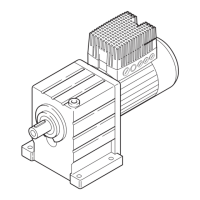Optimising the operating behaviour
Oscillation damping
10
Function library
10.4
10.4.3
L
10.4-4
EDS82EV903-1.0-11/2002
Code IMPORTANTPossible settings
No. SelectionLenzeName
C0144
v
No temperature
depending chopper
frequency derating
1 0 No temperature-depending chopper frequenc y
derating
When operating with a chopper frequency
of16kHzitisalsopossibletoderateitto4
kHz. The behaviour can be changed under
C0310.
^ 10.4-3
1 Automatic chopper frequency derating to 4 kHz, if
ϑ
max reaches
-5°C
C0144 = 0 (no temperature-dependent chopper frequency reduction)
If the maximum heatsink temperature (ϑ
max
is exceeded when using a chopper
frequency of 8 kHz or 16 kHz) the inverter will be inhibited, TRIP ”OH”
(overtemperature) will be set and the motor will coast to standstill.
C0144 = 1 (temperature-dependent chopper frequency reduction is active):
l If the heatsink temperature ϑ
max
-5°C is reached when using a chopper
frequency of 8 kHz or 16 kHz the controller automatically reduces the
chopper frequency to 4 kHz thus keeping the operation running.
l After cooling the heatsink the controller automatically changes to the
chopper frequency set.
)
))
) Note!
The chopper frequency is automatically set to its optimum value
depending on the apparent motor current and output frequency to
ensure trouble-free operation.
l The noise emission changes.
l The user cannot influence this function.
Medium-frequencymotors areonlyallowed to be operated on 8 kHz sin or 16 kHz
sin.
10.4.3 Oscillation damping
Suppression of idling oscillations when:
l the rated power of controller and motor of a drive do not match, e.g. at
operation with high chopper frequency and the related power derating
l Operation of higher-pole motors
l Operation of special motors
Compensation of resonances in the drive
l Some asynchronous motors can show this behaviour when being operated
with an output frequency of approx. 20 ... 40 Hz. As a result, operation can
be instable (current and speed fluctuations).
Automatic chopper frequency
reduction
Tip
Description

